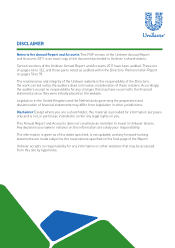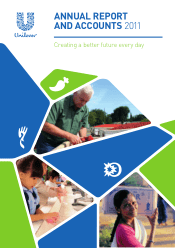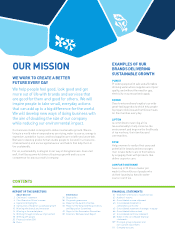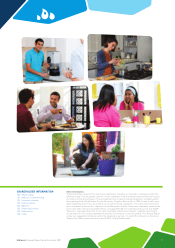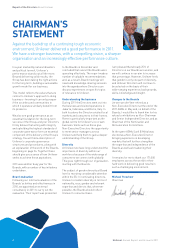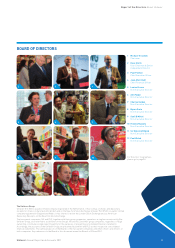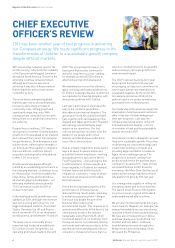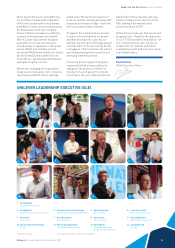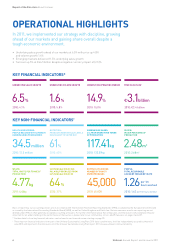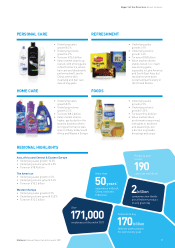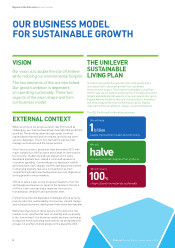Unilever 2011 Annual Report Download - page 7
Download and view the complete annual report
Please find page 7 of the 2011 Unilever annual report below. You can navigate through the pages in the report by either clicking on the pages listed below, or by using the keyword search tool below to find specific information within the annual report.
4
CHIEF EXECUTIVE
OFFICER’S REVIEW
2011 has been another year of real progress in delivering
our Compass strategy. We made significant progress in the
transformation of Unilever to a sustainable growth company
despite difficult markets.
2010. This is a good performance, not
least given that we also continued to
invest for long-term success – adding,
for example, an extra €150 million in
advertising and promotional spend.
We maintained our record for efficiency
gains, reducing overheads anddelivering
€1.5 billion in savings. We also re-affirmed
our reputation for financial discipline, with
strong free cash flow of €3.1 billion.
Last year’s performance should also be
seen in the context of geopolitical
disturbances and natural disasters. The
uprisings in North Africa and the Middle
East, together with earthquakes in New
Zealand and Japan and floods in Thailand,
were among events that had a major
impact on our operations. Our first
concern during these incidents is for the
welfare of our people and for their
families, and thankfully we suffered no
loss of life or serious injury.
How a company responds to these events
says a lot about its values and we are
proud that Unilever employees – working
alongside partners such as the World
Food Programme – were among the first
to offer assistance to those caught up in
these tragedies. In Thailand, for example,
Unilever teams worked tirelessly to
help get our customers – many of whose
stores and warehouses were flooded –
back in business.
One of the most pleasing aspects of the
performance in 2011 was that we
delivered strong results while continuing
to make necessary long-term changes.
Our vision is to double the size of the
business while reducing our
environmental impact. This requires us to
operate very differently. At the heart of our
new business model is the Unilever
Sustainable Living Plan (USLP), which
touches all aspects of our business: from
the way we source our materials, develop
our brands and make our products, to the
way they are used and disposed of by our
consumers. Its basic premise is that in a
2011 was another turbulent year for the
world economy, reflected in the instability
of the Eurozone and sluggish consumer
demand in North America. Growth in the
emerging countries remained robust,
although even here we saw some
softening. It was also in these markets
that we experienced our most intense
competitor activity.
The uncertainty underpinning global
markets gave rise to strong inflationary
pressures and a sharp increase in
commodity costs, stifling growth and
significantly impacting costs. With
unemployment rising and real incomes
falling, there is no doubt that consumers
are suffering.
Despite these conditions, 2011 was a
strong year for Unilever. Underlying sales
growth of 6.5% was ahead of our markets
and continued the trend of improving top
line performance. Growth was price and
volume driven, reflecting the strength of
our brands and their ability to compete in
the most difficult conditions. Recent
acquisition and disposal activity added a
further 1.2% to turnover.
Growth was broad-based, although
fuelled by an outstanding performance in
the emerging markets – a strategic focus
for the business. Driven by markets like
India, China, Turkey and South Africa –
all of which grew by double digits – our
emerging markets business grew by
11.5% and now accounts for 54% of
Unilever’s turnover.
In the developed world, growth was more
subdued, at 0.8%, although even here we
saw some strong performances. Our
biggest developed markets – the United
States, Germany, the UK and France –
which represent 61% of our developed
world business, grew between 1% and 4%.
The sharp rise in commodity prices
meant we had to absorb an additional
€2.4 billion of costs. Despite this, our
operating profit was broadly in line with
resource constrained world, it is possible
and necessary to decouple growth from
environmental impact.
The USLP represents a long-term goal
but progress during the first year was
encouraging, not least our commitment to
source agricultural raw materials from
sustainable supplies. By the end of 2011,
for example, almost two thirds of the
palm oil used in our products was being
purchased from certified sources.
Our leadership in this area has caught the
imagination of employees and customers
alike. It has won Unilever widespread
external recognition. Last year, the
company was named winner of the 6th
International Green Awards – just one
of a number of high profile sustainability
awards received in 2011.
Our business model is designed to provide
long-term sustainable growth. This relies
on delivering our corporate strategy, and
in particular building our brands and
providing bigger and better innovations.
Again, we are making progress. The
proportion of turnover coming from
products launched in the past two years
continues to be above 30%. Sales of Dove
exceeded €3 billion in 2011 driven by
innovations like Men+Care. And the use of
advanced technology enabled our Knorr
jelly platform to grow by 60% last year.
Our strategy relies equally on rolling out
innovations faster and to more markets.
The launch of Axe Excite to 100 markets
in just over a year is typical of the speed
and breadth we are able to achieve.
We are also introducing brands into many
more markets. Magnum, for example, has
enjoyed remarkable success since being
launched in North America and Indonesia.
We have also introduced Dove in China
and Clear shampoo in South Africa. Our
Comfort and Surf fabric conditioner
brands have performed strongly since
being introduced in Australasia, South
Africa and the Philippines.
Unilever Annual Report and Accounts 2011
Report of the Directors About Unilever
1∆

